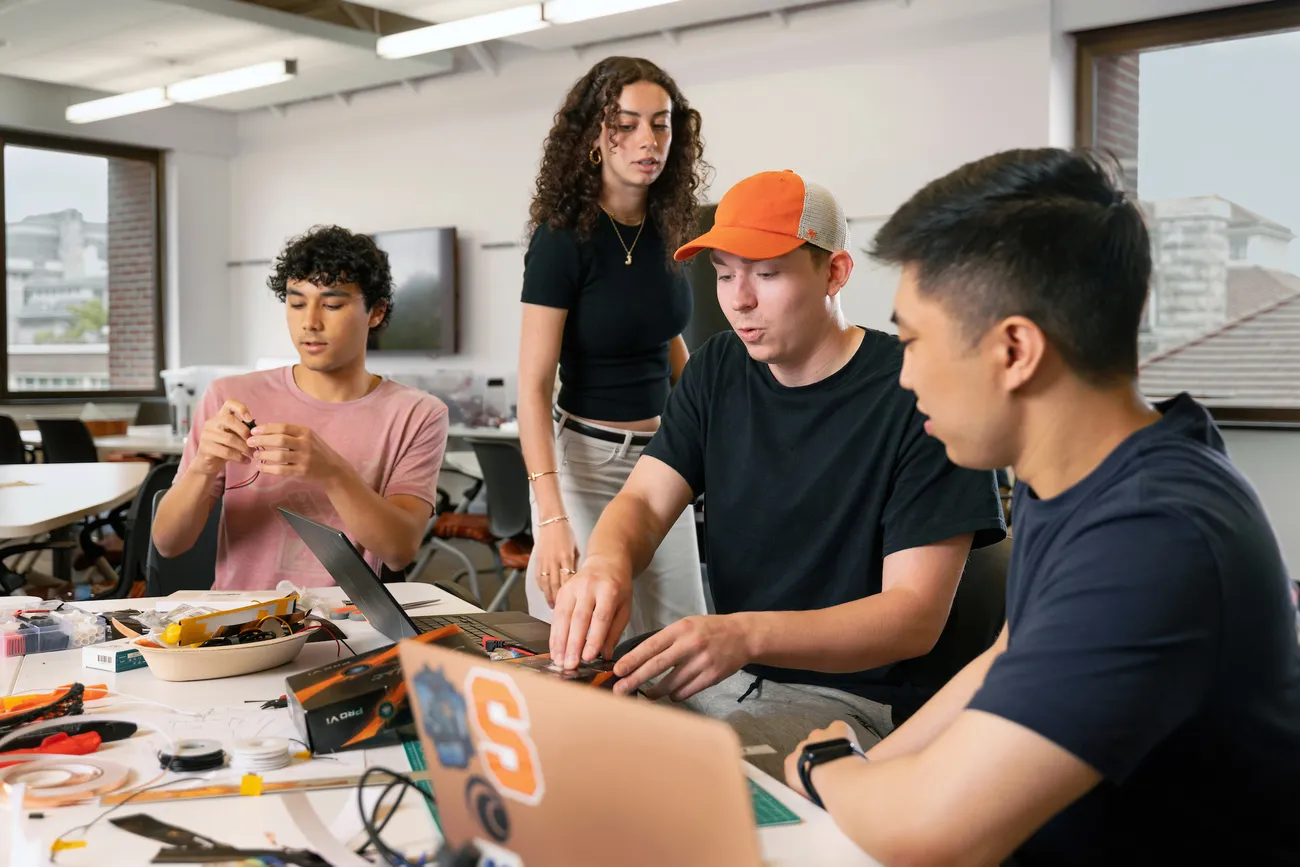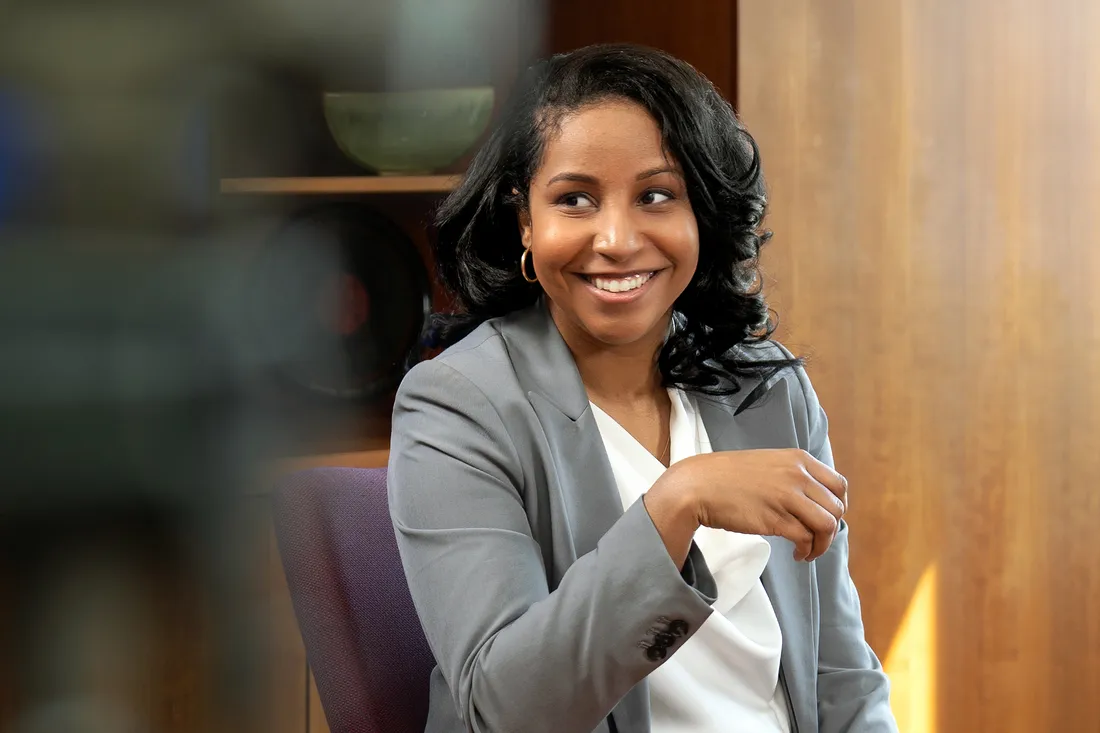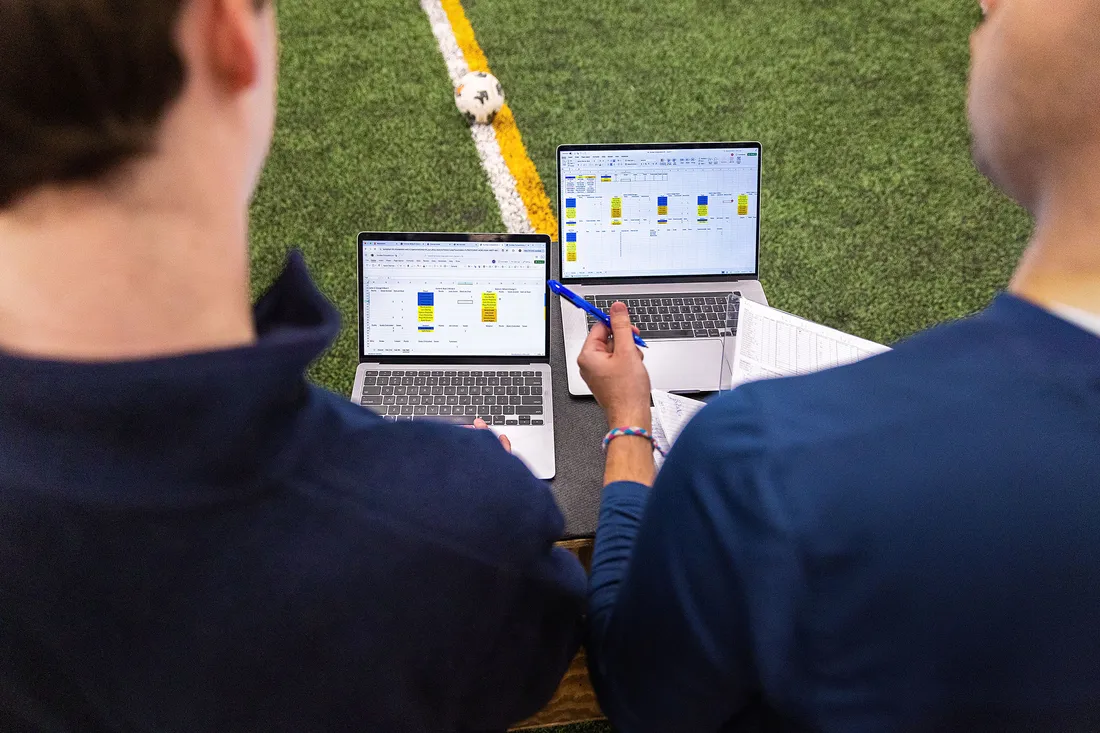Like most students, Alexander Delgado ’27 considers headphones part of his college survival kit. He uses them to not only block out distractions but also listen to music and other audio content.
“They give me a sense of privacy and comfort,” says the computer engineering major. “I feel like I’m in my own bubble.”
Delgado is not alone. According to a study from the National Institutes of Health, 80% of U.S. college students use headphones daily. Part utility, part accessory, they’re ubiquitous in our tech-driven world.
But headphones can pose hidden dangers, Delgado warns. “They reduce situational awareness, making us vulnerable to crime and accidents,” he says. “Prolonged use, especially at high volumes, can lead to noise-induced hearing loss.”

Alexander Delgado ’27 flanked by Angelo Fernandez ’27 (left) and Stanley Gao ’27 (right). They developed a situational awareness device at Invent@SU, a six-week summer program in the College of Engineering and Computer Science.
Earlier this summer, Delgado was part of a group of undergraduates that applied their education to create real-world solutions. They attended Invent@SU, a popular, six-week program in the College of Engineering and Computer Science (ECS).
Eight teams of students designed and prototyped original devices—from a wearable emergency alert system to a dryer lint alarm to two different golfing appliances—and then pitched them to industry experts and investors. Along the way, the teams refined their inventions based on weekly feedback from guest evaluators. They also learned about ideation, intellectual property and teamwork.
Delgado helped invent Third Eye, a clip-on wearable that detects people approaching from behind and sends directional audio alerts.
The device is billed as an “eye for your blind spot.” Compact. Lightweight. Easy to integrate into wireless headphones and earbuds. “It gives headphone users peace of mind while they’re walking alone, especially at night,” he adds.
“Invent@SU is an immersive invention accelerator,” says director Alex Deyhim, the Kenneth and Mary Ann Shaw Professor of Practice in Entrepreneurial Leadership in ECS. “It’s all about creative problem-solving.”
Process Over Product
Invent@SU is a summertime tradition in Link Hall, where student inventors and innovators ply their trade. While only a few such devices get past the funding stage, attendees revel in the creative journey. The process.
Emphasis is on problem identification, market research and prototype development, Delgado explains. “Manufacturing, marketing and scaling your invention come later.”
No sooner had the students arrived than they began defining the scope, context and goals of their project. Delgado was surprised to learn that headphone usage is more than a fad. It’s considered “common behavior” among most Americans, especially 18- to 29-year-olds.
At the heart of the $3 billion industry are noise-cancelling headphones. While such devices help promote good hearing health, they also can hinder the brain’s ability to filter noise.
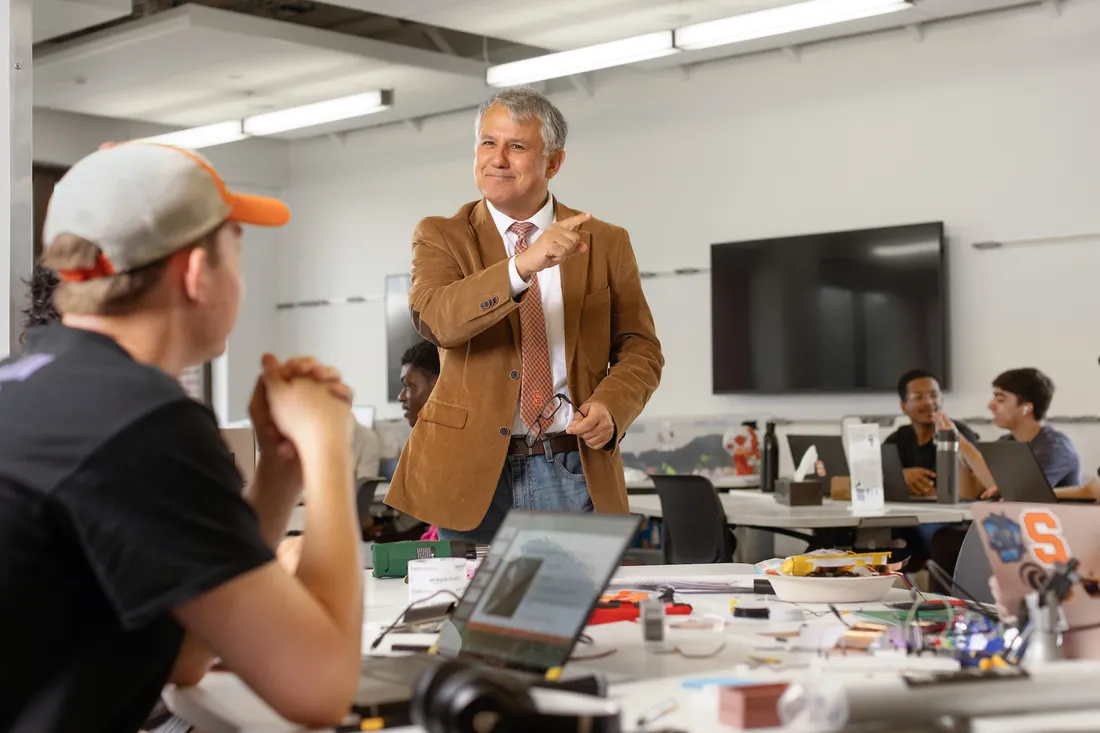
“Invent@SU is all about creative problem-solving,” says director Alex Deyhim, who brings more than 30 years’ industry experience to the program.
Understanding the difference between hearing and listening, Deyhim notes, is what sets Third Eye apart from other so-called situational awareness devices.
“Alexander’s group realized that one of their target audiences—teenagers—processes noise and speech differently from older adults,” he says. “This is because high-level listening skills don’t finish developing in the brain until the late teens.”
Delgado’s team spent nearly a third of Invent@SU examining the effects of headphone usage on different age groups and conducting marketing analysis. Their research confirmed what they had suspected—that wearing headphones can make users less aware of their surroundings.
And with vulnerability comes risk. “You become a target,” says Delgado, citing joggers, pedestrians and those suffering from hearing loss as prime examples. “Third Eye makes people feel safe and aware.”
A Eureka Moment

Douglas Yung (right), associate teaching professor of biomedical and chemical engineering, counsels a student at Invent@SU. Yung lent his expertise to a range of projects, including this one—an outsole system that lets athletes switch footwear for different sports and turfs.
Student-faculty interaction figures prominently at Invent@SU. Working with Deyhim and his teaching staff, Delgado discovered that situational awareness devices are nothing new. And many such gadgets use external mics, making them unreliable.
“Mics can compromise comfort and privacy,” interjects Deyhim, who brings more than 30 years’ industry experience to ECS.
One alternative was a thermal imaging camera, but Douglas Yung, associate teaching professor of biomedical and chemical engineering, convinced the team otherwise. “He reminded us that thermography requires video processing, which would slow down our detection rate and reduce our efficiency,” Delgado says.
Yung steered them toward a passive infrared (PIR) sensor, which measures infrared light radiating from objects. Combined with a time-of-flight camera, a PIR sensor can deliver precise, energy-efficient motion detection to the user in real time.
Despite waiting two weeks for parts (and then learning how to use them), Delgado’s team made formidable progress.
Connecting Third Eye to Bluetooth was their eureka moment. “After running multiple tests and trying multiple approaches, we finally asked for faculty help. Hearing those first signals was euphoric,” he says smiling.
From Concept to Creation
Other teams recount similar trial-and-error experiences. Computer science major Andy Rivera ’28 helped develop WashSentinel, a laundry security device that detects unauthorized washer or dryer access. The prototype swept Invent@SU’s competition based on its ability to send phone alerts and prevent theft with a built-in alarm.
“We devised a triple-axis accelerometer to detect unauthorized door movement,” Rivera recalls. “It can be mounted on any washer or dryer and doesn’t require tools.”
He admits that the end-result differed from the initial concept, which included magnetic and reed sensors (“too inconsistent in a noisy laundromat environment”) and an “overly complicated” detection code.
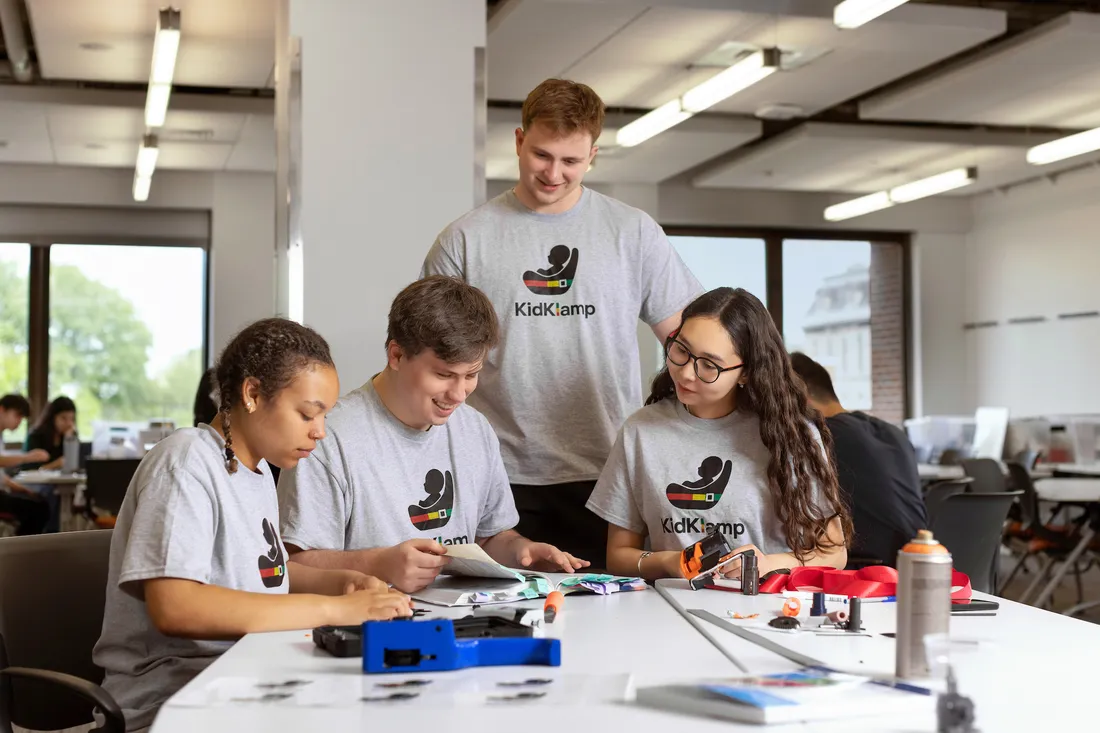
Darika Djusupova ’28 (far right) credits Invent@SU for giving her “hands-on experience” that supports her academic and career goals.
Credit Yung for helping Rivera’s group install an isolation pad to absorb vibrations created by the operation of the equipment. Yung also calibrated their sensors for the live demos.
Equally beneficial were critical insights from Cindy Smith, assistant teaching professor of biomedical and chemical engineering and electrical engineering and computer science; Alex Dunbar ’97, ECS’ marketing and communications manager; and Rich Polgar ’98, G’99, G’19, a successful entrepreneur whose family owns a chain of laundromats.
Feedback from student, faculty and alumni surveys also “refined our approach,” Rivera says.
Computer science major Darika Djusupova ’28 acknowledges the positive research culture of Invent@SU. Only in such a stimulating environment could she have helped realize KidKlamp, which provides an easy way to install infant car seat bases.
“I got hands-on experience in engineering design, teamwork, entrepreneurship and problem-solving,” says Djusupova, whose invention placed second at Invent@SU. “These skills directly support my academic path and my future career in tech and innovation.”

